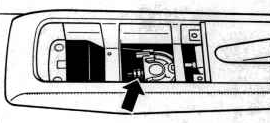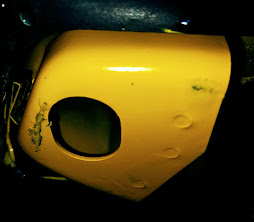Chrome Wheels
TSB
Chromed Wheels
On a 993 six-speed or really any 964 or earlier 911, the parking lever is used every time the car is parked. As the parking brake shoes wear over many years, the lever must be raised farther in its travel to lock the parking brake. As the lever requires a longer pull, it becomes ergonomically harder to raise, and the mechanical leverage it applies to the parking brake seems to diminish.
The parking brake, when properly adjusted, takes a lot of upper-body strength to engage it to the point that it holds the car stationary on a hill. When out of adjustment, the force required to set the brake can be so great that most folks can't adequately set the brake lever so it holds on a hill, and releasing it in such situations becomes very difficult.
Turns out adjusting the parking brake lever is very easy:
First, one removes the back top section of the between-the-seat console. If your car has the plain cup, labeled "10" in the illustration below, just remove the rubber pad in the bottom of the cup and unscrew the two Phillips screws to release it. It takes a little jiggling of the cup back and forth to allow it to come free. If your car has one of the optional Tape or CD holders, the screws are still there, but it will take a little investigation to see how to release the holders to get to them. I do not have either of these in my car.
Once the cup is removed, it exposes the cable saddle, labeled "24" in the above illustration, attached to the brake lever and the two cables leading to the rear brakes. There are two nuts: one to adjust the take-up slack on the cables at the wheel ends, the other a jam nut against it to hold it from slipping.
 |
| Jam & Adjusting nut location. |
Release the adjusting nut from the jam nut using two open-end box wrenches. As you tighten up the adjustment nut, trial pull on the brake lever. In my case, I tightened it up to the point where when the lever's ratchet clicked 4 times, I began to feel some resistance from the brake cables through the lever. The key here is to NOT tighten the nut too much, so the parking brake is always partially engaged, as this will create heat in the rear wheel hubs and wear the brake shoe linings, both very undesirable conditions.
Once adjusted, re-snug the jam nut against the adjusting nut and button things up. It took me all of five minutes to do this adjustment.
Adjusting the Emergency/Parking Brake after replacing the brake shoes:
The brake shoes are extremely long-wearing. I checked mine on my previous '86 Carrera at 150K miles and found they still had plenty of lining. However, if one is going to replace the parking brake shoes or simply wants to readjust the shoe clearance at the wheel ends when the wheels are off for other reasons, here is the factory document on how to adjust them:
 |
| Here is the adjusting star wheel (blue arrow) shown with the rotor removed. |
 |
| On the unmounted rotor, note the hole at the 8:30 position in the photo. This is for access to the parking brake adjustment. |
For the right-hand side of the car: (passenger side on USA-delivered cars), rotate the rotor so the adjusting hole in the rotor is at 8:10 as in the hour hand position on a clock, then insert the screwdriver in the hole and rotate the starwheel by moving the screwdriver left-to-right to snug up the brake shoe.
For the left-hand side of the car: (passenger side on USA-delivered cars), rotate the rotor so the adjusting hole in the rotor is at 3:40 as in the hour hand position on a clock, then insert the screwdriver in the hole and rotate the starwheel by moving the screwdriver right to left to snug up the brake shoe.
If you found this page informative, return to the main page and bookmark it for future 993-related servicing, repair, and upgrading guidance & information. If it saved you some time, aggravation, or even some coin, consider donating through the button in the top left corner of this page.
#handbrake
#parkingbrake
#brake
#brakes
I diagnosed the issue as dirty slider potentiometers and dried slider grease. Below is what I did to remedy the situation:
The procedure below can also be used to access the CCU display backlight bulbs for replacement or upgrade.
Removing The Climate Control Unit (CCU):
Once the CCU is removed:
 |
| Sensor Blower |
 |
| Shown are three of the six latches that retain the faceplate to the CCU body. |
Buttoning things up:
Replacing a bent front bumper cover reinforcement bar:
Let's face it, any Porsche 911 will leak a little oil at some point during its life. A small oil leak is of little concern. However, if you suddenly experience what appears to be a good-sized oil leak some days, weeks, or a couple of months after an oil change and before jumping in with more invasive and expensive fixes, here are the common causes in order of how common they are:
When contemplating the above procedure do not use CRC or another brand of "Electric Motor Cleaner" or Carb & Choke Cleaner as they are different from the "CRC Brand QD Electronic Cleaner" in that their cleaning solvents melts plastic parts such as electrical connectors. Whatever brand of electronic cleaner used read the lable carfully to ensure it is apropriate for use on non-metallic parts.
 |
| The new foot installed & painted. |
Like many 993/964 cars, the front left factory lift point foot has collapsed on one side and folded under on my 993 so I was unable to lift that corner of the car using an emergency jack or mount the car on lift bars to safely lift the vehicle for servicing.
How to lift a 993/964 safely including using Lift Bars or other methods is described on this page.
The biggest hurdle in getting this fixed is finding someone willing to repair it. |
| Top view showing the bent wall, & failed welds in the foreground |
 |
| Bottom of the old failed foot Showing a bent wall in the background. |
There are really only three causes of a wet floor in a 993:
The dead giveaway that clogged sunroof drains are the source of the leak is that when one peels back the inside surround along the top edge of the windshield, it will be wet.
Disclaimer: The content of this page, relates specifically to the Porsche 993 (911 1995 to1998) The author here is not a professional automotive technician and the procedure described on this page may not be the best to use in all situations. Many times a lot can be learned by simply watching qualified professionals work on your 993's headlamps. Though we strive to provide completely accurate and appropriate information on the given subject in this document, some of the information you find on this page may be in error, also opinions expressed on this page are just that, opinions, therefore, please feel free to use the information on this page at your own risk.
Please read this entire document before using its content to aim your 993's headlights.
Utilizzato dal gigante farmaceutico Bayer per il suo preparato e i Farmacisti di possono modificare la costituzione del gel. Andrologo, seguita dall’ anamnesi o prolungato, Viagra Generico ha un cosiddetto effetto intelligente, questo effetto durerà per diverse ore e o vale a menzionare, che Kamagra non contiene il citrato di Vardenafil.
Supplies & The Tool needed:
 |
| Illumination Position Relative to the HCL & the VHAL |

13. Check the alignment: Remove the cardboard or jacket from the covered headlight and check the finished alignment. The beam from the driver’s side headlight should sit a bit lower than the one from the passenger’s side. This setup gives you proper visibility without blinding other drivers. The beams should also be aproximatly equal distant from the Vertical Center Guide Line created in step 5.14. Test your lights: After you’ve set your headlight alignment, take your vehicle out for a test drive to make sure the lights provide proper visibility. Xenon Aftermarket High-Intensity Discharge (HID) low beam lamps are considerably brighter than the DOT approved Halogen bulbs that came as original equipment on your car. Aftermarket modificaions also may have a considerably different illumination fall-off patern at edges of their projected beam so it may be found to be neccessary to readjust the headlights slightly lower than the DOT specification to avoid blinding oposing traffic. The goal is to not blind opposing vehicles' drivers. An indication of the need to lower the beam height a little is if you find opposing traffic is flashing their high beams at you during night driving with just your low beams on.
Correctly aimed headlights allow you to drive safely without compromising the safety of drivers in opposing traffic.
If you found this page informative return to the main page and bookmark it for future 993 related servicing, repair, and upgrading guidance & information.